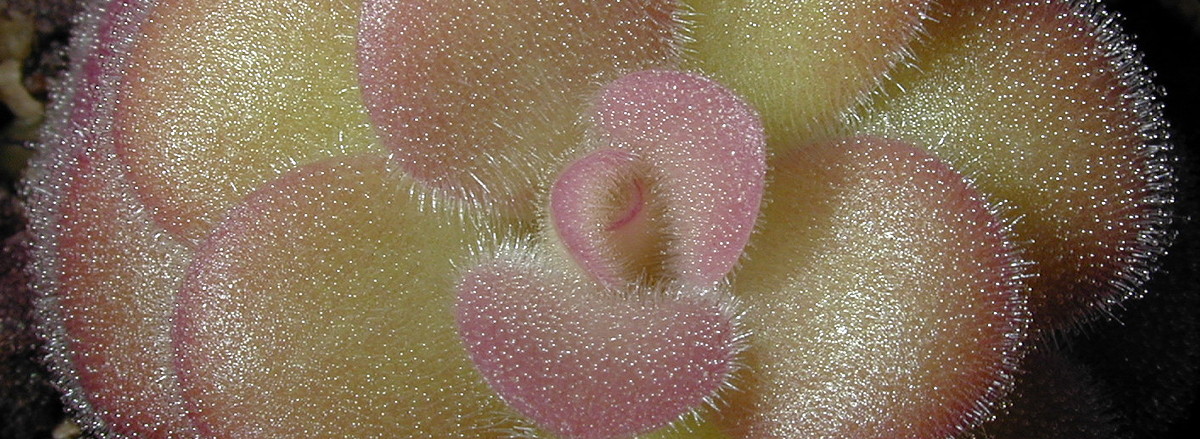
Pinguicula agnata
Mexican Pinguicula make excellent house plants and are among the easiest carnivorous plants to grow. In the wild, many Mexican Pinguicula grow in seasonal fog forests on limestone cliffs and tree trunks. Some grow in moss, others just cracks in the rocks, quite often on north facing cliffs with little or no direct sunlight. With 55 to 65 species in the Central American and Caribbean subgenus of Pinguicula, there is a tremendous amount of variation in the plants and the conditions under which they grow. To understand more about the lives of Mexican Pinguicula please see the travelogues and species discussions at World of Pinguicula.
Do NOT ever use any kind of fungicide on Pinguicula. This includes all Pinguicula species. I don't know why but fungicides are death even in the soil. This even includes cinnamon which can be used as a fungicide on other plants. Certain pesticides will harm and possibly kill Pinguicula. Use pesticides with caution.
Most of the Mexican species have heterophyllous leaves—the summer leaves are slimy and carnivorous; the winter leaves are succulent and not carnivorous. The plants like warm humid conditions when in the summer, carnivorous state. During the winter when they are in the succulent state, they should be kept cooler and drier. Since these conditions are typical of those in a house they make great house plants in a bright sunny window or under lights. If you can grow African violets you can grow most Mexican Pinguicula.
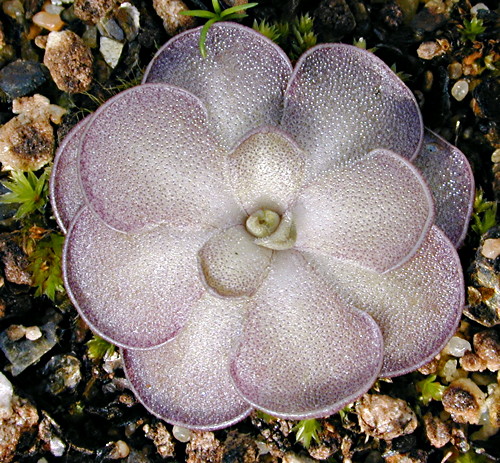
Pinguicula cyclosecta has heterophyllous leaves in the summer and fall. These leaves are carnivorous. They have drool edges. The upturned leaf edges keep the digestive juices from flowing off the edge of the leaves.
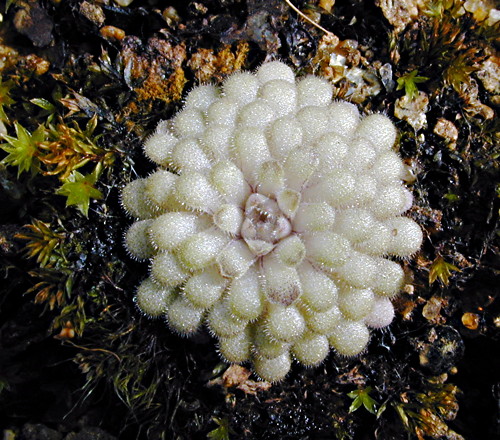
This is the same Pinguicula cyclosecta plant in the winer at about the same scale. It has small, succulent, non-carnivorous leaves. This is the best time to propagate and repot the plant.
There is some controversy over the best way to grow Mexican Pinguicula. Techniques that some growers swear by are death in other hands. Mexican Pinguicula are NOT bog plants and should not be grown like bog plants. Plants in the standard peat and sand "CP mix" may or may not do well depending on your exact conditions and which species or hybrid you have.
The main issue with soil mixes is matching the weight or water holding ability of the soil to the watering method, temperature and humidity. Plants grown in humid greenhouses with misty or overhead watering need to be in a light or more loose soil mix. Plants grown in a typical house or classroom need a heaver, water absorbent mix. I rarely top water my plants and the pots are usually sitting in a cm of water from spring to fall. That is the reason I recommend a heaver mix than many growers at World of Pinguicula who grow their plants under more humid conditions and top water.
Most Mexican Pinguicula prefer an alkaline soil mix. I have found a good mix for house plant Pinguicula to be one part each of peat, coarse sand, and perlite. Dolomitic or limestone sand would be best if you can get it. This would counteract the acidity of the peat. I use silica sand blasting sand in the mix because that is what I can get. I then add dolomitic lime (a soil amendment found in garden shops) to the mix. I put in about 1 tablespoon of dolomitic lime per cup of soil mix. That may seem like a lot but the plants do much better with it there. Another option if you want to soil fertilize the plants is to use a modified version of this mix. I am having good results for most species using a standard, peat and compost-based organic potting soil mix in place of the peat. The potting soil comes already pH adjusted. I still add some dolomitic lime. Some brands of potting soil are a little heavy on fertilizer which can be deadly to certain species when they are dormant. Stick with "organic" mixes that do not have chemical fertilizers.
There are other options for soil mixes that also work well in non-greenhouse conditions. You can use pumice in place of the perlite. Some growers may use vermiculite but it breaks down quickly getting slimy and requiring you to repot often. You can throw in some fine orchid bark but it will degrade in a year or two. Ground bark might actually be better and a good substitute for peat since it would be less acidic. A problem with bark products is many that are sold for orchids have an unknown amount added fertilizer and can harbor fungus.
For greenhouse conditions, most growers prefer a pure mineral soil mix. This is fine if there is a small amount of fertilizer in the water. Yes, Pinguicula do appreciate light soil fertilization. Using potting soil instead of vermiculite in the mix would provide some fertilizer retention in the soil. Be very careful if the plants are in trays that hold water and there is fertilizer in the water as it is very easy to over fertilize the plants and burn them.
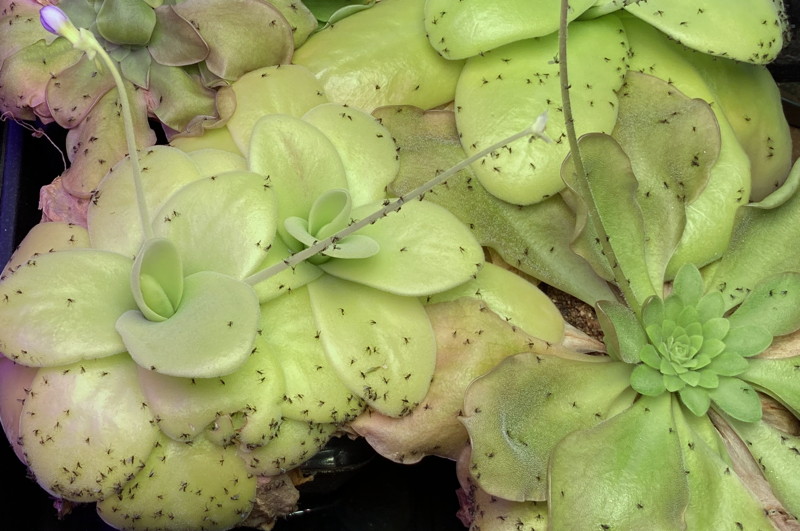
After planting the Pinguicula plants, I put a layer of coarse silica sand on the surface of the soil up to 5 mm thick to discourage fungus gnats. Fungus gnat larvae like to eat Pinguicula leaves. Yes, Pinguicula plants can get covered in adult fungus gnats if there is an outbreak, but their larvae could be doing considerable damage to small plants. Please see the ICPS webinar called Carnivorous Plant Diseases, Pests, and Cures with Damon Collingsworth for information on protecting plants from fungus gnat larvae using Mosquito Bits which contain the bacteria Bacillus thuringiensis israelensis.
I plant all my Pinguicula in 9 cm tall plastic pots and they are grown using the classic tray method. When the plants have carnivorous leaves I use a water depth of up to 2 cm in the trays but do not worry if the trays dry out for a few days. When the plants are in the succulent phase I let the trays dry out for a week or so between waterings. The advantage of a soil mix with light weight ingredients is you can tell how how wet the soil is by just picking up the pot.
Many of the Pinguicula hybrids bloom over a longer period of time than pure species. After about five years they need repotting because the deep thatch of old leaves get in the way of the new roots reaching the soil from the growing plants. You may want to repot the plants more often than that if a salt crust forms at the soil surface.
Most if not all Mexican Pinguicula cannot self pollinate their flowers for physical reasons. The stigma forms a flap over the anthers. The outward facing part of the stigma is the part receptive to pollen. The inward facing non-receptive part covers the anthers keeping the pollen from getting to the receptive part of the stigma without mechanical assistance from a pollinator, usually a hummingbird.
Because of the way the flowers are constructed, it is tricky to pollinate them by hand. The easiest way to pollinate the flowers is with a tooth pick. You could play hummingbird tongue by poking the toothpick in and out of the flower trying to pick up the pollen from the anthers on the way out and deposit it on the stigma on the way in. However a more reliable way is to rip the flowers to get at the anthers and stigmas directly. To rip the flowers hold the top petals with one hand and the lower petals with the other and carefully tear off the lower petals. Do not touch the stem as you are likely to damage it. You can use a toothpick to transfer pollen the from the anthers to the stigma or use a forceps to remove the stamens and paint the stigma with the anthers. It may take some practice.
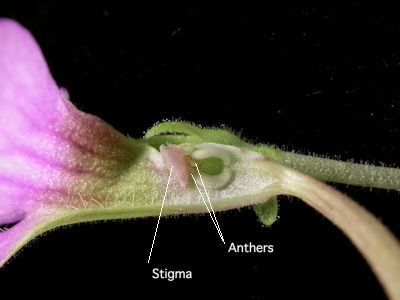
In Pinguicula flowers the stigma forms a flap over the anthers. The receptive side of the stigma is the outer part so the flower will not self pollinate. This flower is "opened" to see the details.
The flowers are usually pollinated by humming birds. As a bird sticks its tongue into the flower any pollen on the tongue is deposited on the receptive part of the stigma. As the bird removes its tongue it collects pollen off the anthers without getting any (or much) on the top of the stigma.
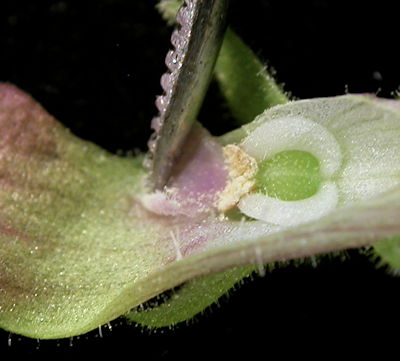
A forceps is holding up the stigma to see the anthers at the top of the C-shaped stamens.
For good germination the seeds need temperatures between 15°C and 25°C (60°F to 80°F). To prepare a pot to start your seeds, fill it most of the way to the top with your favorite mix with the top cm being a sifted part of your mix so it is finer. Place the seed on the surface of the medium and don't bury it. The soil should be damp and not sopping wet. You may want to put the pot in a plastic bag if your environment is dry. You get better control germinating seeds under lights although in the shade of a greenhouse works. Seeds germinate in 4 to 8 weeks. Please see Sowing Seeds Step-by-Step for more details on starting seeds.
Heterophyllous species of Mexican Pinguicula need seasonal light cues to be maintained long term. With proper light cues most species will have carnivorous leaves from mid spring through fall. Winter through early spring they will have succulent, non-carnivorous leaves. To give the plants the proper lighting, you need to grow them in a greenhouse, sunny window, or have plant lights on a timer that can be set to change the on and off times according to the seasons. Day length is not as important as slowly increasing or decreasing day length. Heterophyllous leaved species grown under continuous light period will essentially get stuck in the non-carnivorous phase. Homophyllous species such as Pinguicula gigantea do tolerate an un-changing light period but may not bloom.
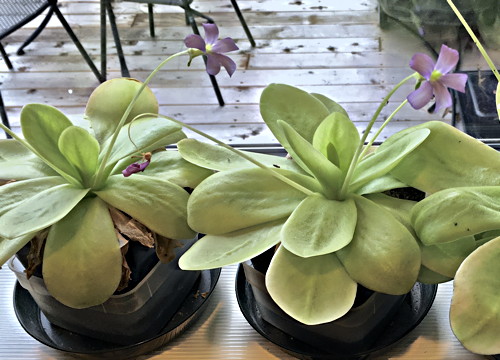
Pinguicula gigantea makes a great window sill plant. This species does not form succulent leaves in the winter but the plants do get smaller. They bloom in early winter. They may be propagated at any time of the year.
Mexican Pinguicula are best propagated from leaf pullings. Please see Mexican Pinguicula Leaf Pullings for instructions.
-- John Brittnacher
September 2001
Latest update March 2022
For more information please see:
Beckstrom, Marc 1979. A Search for Mexican Pinguiculas. Carniv. Pl. Newslett. 8(2):55-57 (PDF)
Powell, Charles L. 1987. Mexican Pings. Carniv. Pl. Newslett. 16(4):106-110 (PDF)
Lau, Alfred B. 1993. The discovery of a new Pinguicula from Ayautla, Oaxaca, Mexico. Carniv. Pl. Newslett. 22(1-2):26-27 (PDF)
Wix, Loyd. 1996. Two interesting Mexicans: Pinguicula acuminata and Pinguicula macrophylla. Carniv. Pl. Newslett. 25(4):112-115. (PDF)
Wix, Lloyd 1998. Pinguicula emarginata -- a variable and distinctive Mexican species. Carniv. Pl. Newslett. 27(4):121-123 (PDF)
Meyers-Rice, Barry. 1999. Judith Finn on growing Pinguicula laueana. Carniv. Pl. Newslett. 28(4):126-127. (PDF)
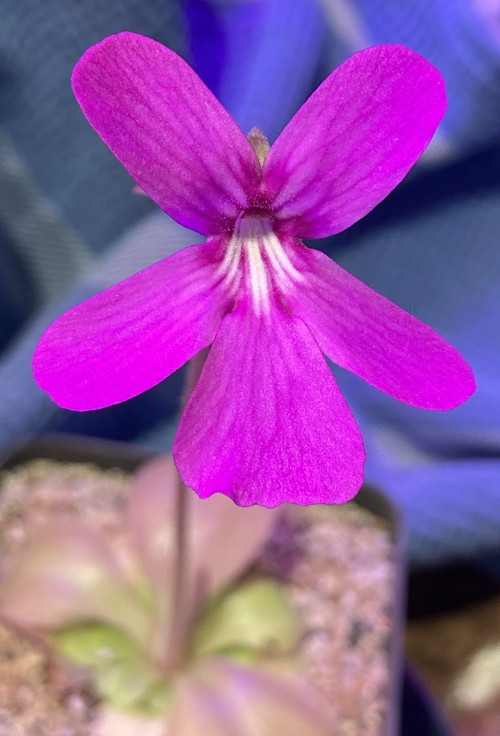
Pinguicula moranensis "J" flower.
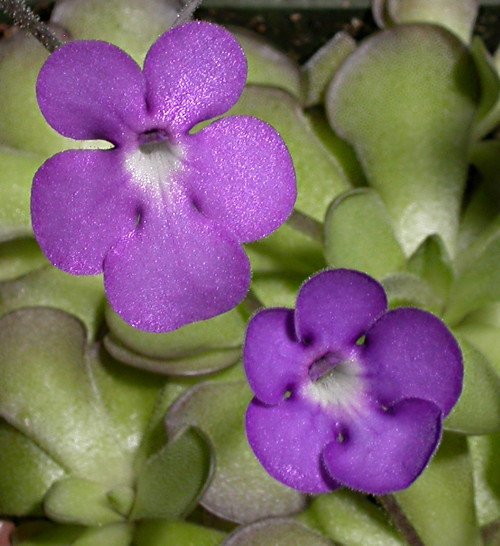
Pinguicula cyclosecta flowers. These plants are growing next to a window and are greener and larger than plants grown in a bright greenhouse. Plants in the wild look more like this.
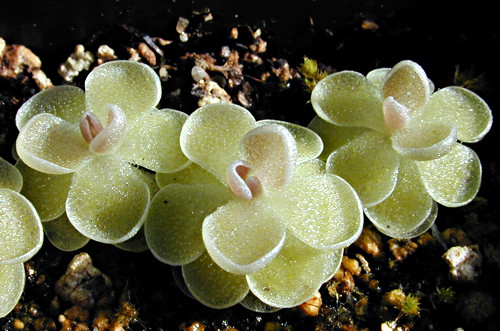
P. ehlersiae plants are a few cm wide and quite cute.
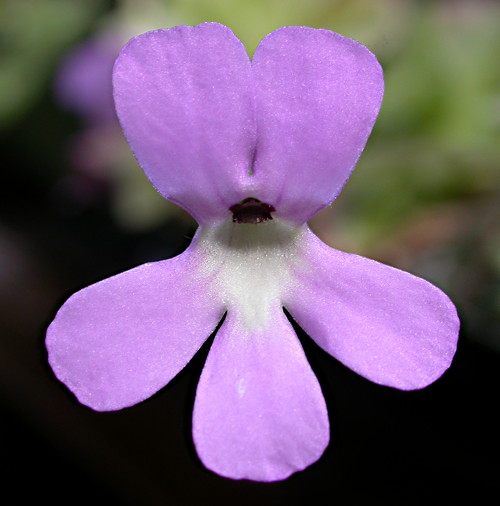
Pinguicula ehlersiae flower.
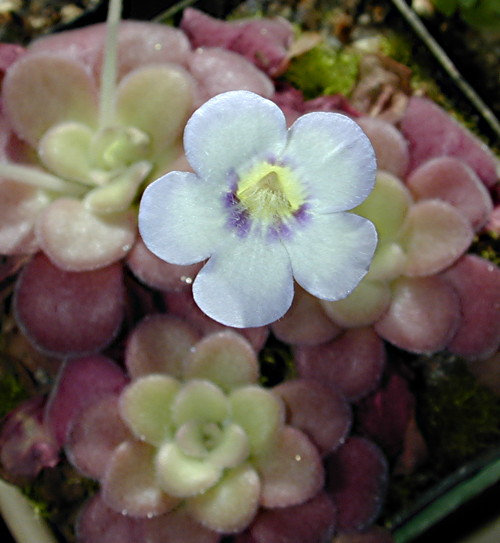
Pinguicula agnata is an easy to grow species.
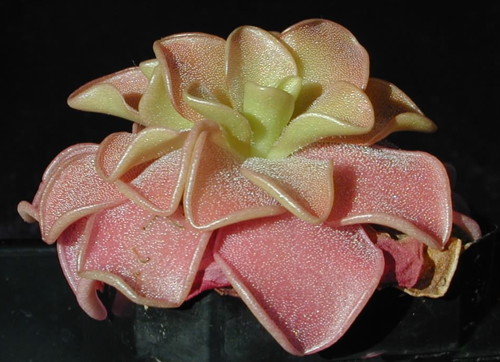
Pinguicula 'Pirouette' is a complex hybrid: Pinguicula agnata x (moranensis x ehlersiae). Most Mexican Pinguicula species can be hybridized.
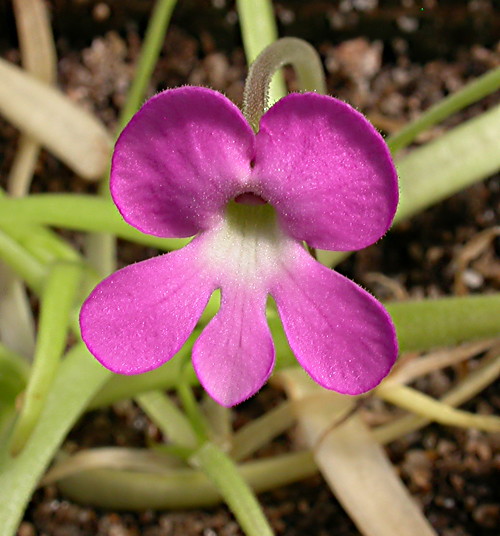
Pinguicula moctezumae is easy to propagate from seed. But you need to pollinate the flowers by hand or let hummingbirds do it for you.
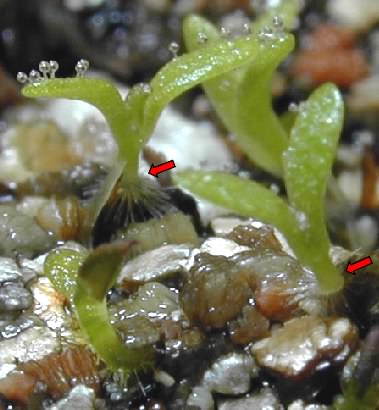
Pinguicula moctezumae sprouts. Note the cotyledons have glands! This may be common among Pinguicula but most other CP genera have cotyledons totally unlike their regular leaves. The red arrows point to something else not expected. They have a stem-like tap root with root hairs. While the presence of a tap root is the norm among plants, in Pinguicula, a tap root is only seen in newly sprouted seedlings. In the upper sprout you can see a typical Pinguicula adventitious root extending from the base of the first leaf formed.
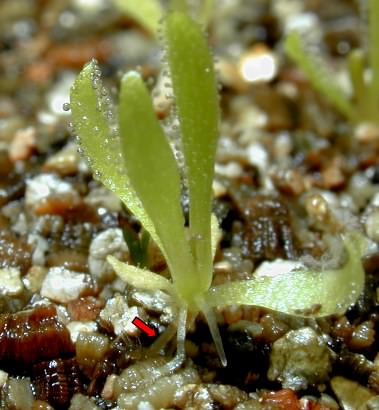
Here is a Pinguicula moctezumae seedling a few weeks later. The red arrow points to the degenerating tap root/stem. The plant is squatting down into the usual Pinguicula position. Note the adventitious roots coming out of the bases of the leaves.
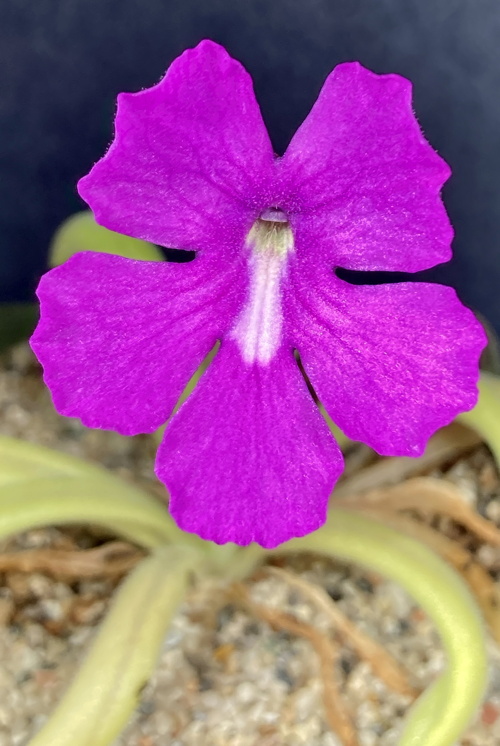
Pinguicula moctezumae x zecheri.
